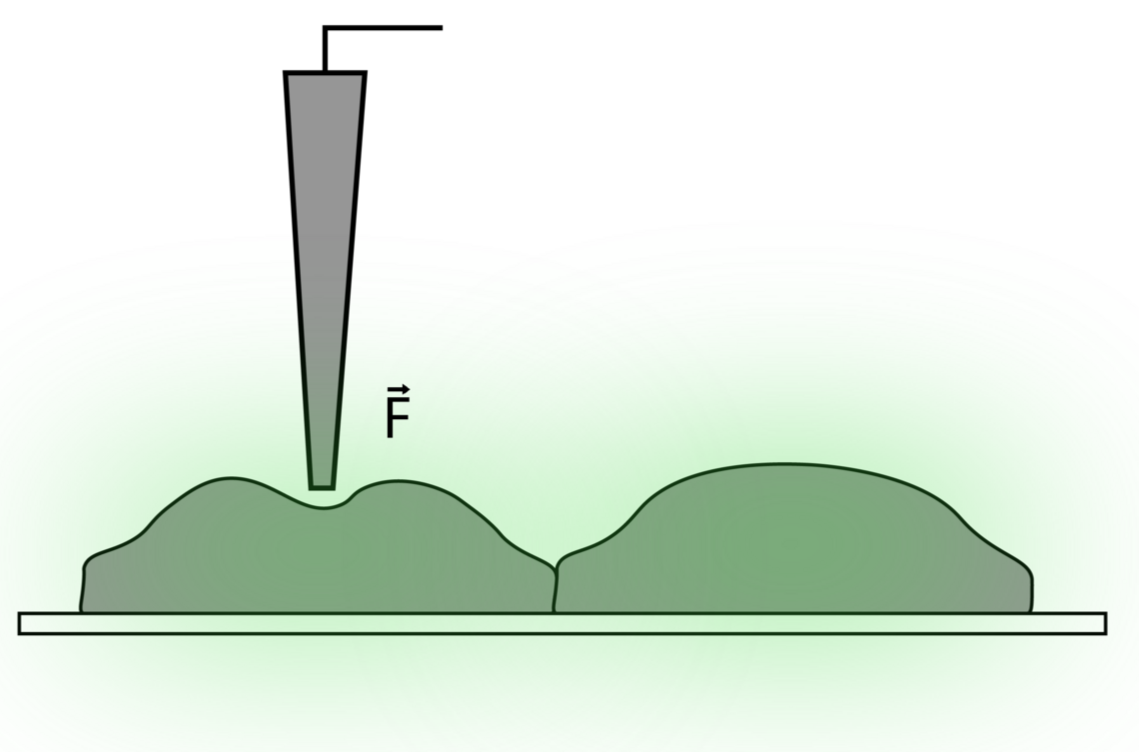








References
11 - Sánchez, D. et al. (2008) ‘Noncontact measurement of the local mechanical properties of living cells using pressure applied via a pipette’, Biophysical Journal. Biophysical Society, 95(6), pp. 3017–3027. doi: 10.1529/biophysj.108.129551.
12 - Stiffness paper
11 - Sánchez, D. et al. (2008) ‘Noncontact measurement of the local mechanical properties of living cells using pressure applied via a pipette’, Biophysical Journal. Biophysical Society, 95(6), pp. 3017–3027. doi: 10.1529/biophysj.108.129551.
12 - Stiffness paper



Applying a positive pressure to the tip of the pipette can be used to measure the nanomechanics of single cells through displacement of the sample surface. The mapping of cellular nanomechanics uses a constant pressure applied as the nanopipette as it moves across the cell, in a similar fashion to hopping mode in SICM. The cellular stiffness is measured in Young’s modulus11.
As the nanopipette does not touch the cell surface, the tip does not get contaminated and multiple stiffness measurements can be taken in one experiment.
As the nanopipette does not touch the cell surface, the tip does not get contaminated and multiple stiffness measurements can be taken in one experiment.
SICM has the ability to exert local pressure on a sample surface by applying pressure to the opening of the nanopipette. For example, application of negative pressure causes liquid to flow into the pipette tip and upon application of positive pressure, a local pressure builds up around the pipette causing the sample surface to indent. Applying a negative pressure to the nanopipette tip can be used in molecular nanomechanics whereby the negative pressure causes large molecules protruding from a lipid bilayer to move towards the pipette tip, where they become trapped. The trapping of molecules within the lipid bilayer allows for the investigation of local mobility and organisation of membrane-associated proteins.

SICM is a useful platform for nanomechanical studies of both molecules and living cells. Nanomechanical measurements can be obtained with or without applied pressure to the nanopipette. Applications for this novel SICM method include manipulation of molecules in lipid bilayers and stiffness mapping of living cells.
SICM offers a major advantage for measuring nanomechanics as, unlike other methods such as atomic force microscopy, the nanopipette does not make contact with the sample surface.
SICM offers a major advantage for measuring nanomechanics as, unlike other methods such as atomic force microscopy, the nanopipette does not make contact with the sample surface.
Quantitative nanomechanical mapping

When using SICM to gain topographical data from a cell surface, as the nanopipette drops towards the surface, the current flow through the pipette drops. During the approach to a soft cell, the current drops much slower than a drop onto a hard surface. This is due to repulsion between the cell surface and the tip of the pipette. This principle underlies another method of measuring nanomechanics which does not use applied pressure.
This novel method is based upon the deformation of a decane droplet to calculate the intrinsic force between the pipette tip and the sample surface. Decane droplets have well-known elastic properties and therefore the force exerted onto the cell surface by the pipette tip can be calculated. This force is then used to calculate the Young’s modulus for the sample surface.
This novel method is based upon the deformation of a decane droplet to calculate the intrinsic force between the pipette tip and the sample surface. Decane droplets have well-known elastic properties and therefore the force exerted onto the cell surface by the pipette tip can be calculated. This force is then used to calculate the Young’s modulus for the sample surface.

ICAPPIC Limited (main office)
+44 (0) 208 383 3080
info@icappic.com
Address: The Fisheries, Mentmore Terrace, London, E8 3PN, United Kingdom

